This is a definitive guide to choosing route optimization software.
In this new guide for 2020, you’ll find out everything you need to know about picking out the best route optimization software for your company, including:
- What is route optimization software and what it’s for (in the first place);
- How does route optimization work;
- What’s wrong with manually planning routes;
- How does route optimization software benefit your business;
- And more.
And at the end, you will get a chance to try out one solution straight away.
So, if you want to get the best route optimization software for your business, this guide is for you.
Let’s get started.
What is route optimization software?
Route optimization software is a tool for planning routes automatically. It helps you plan the best routes by mapping multiple delivery stops for all of your drivers or vehicles in all of your delivery fleets.
But it’s not just used for reaching point B from point A. Route optimization software lets you plan multiple routes that have multiple drop-off or pick-up destinations.
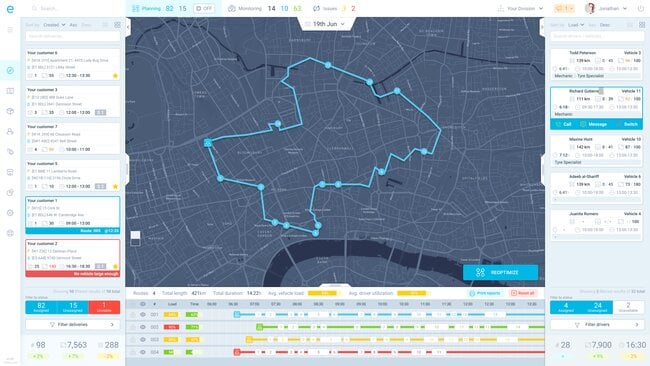
The tool is designed for managing field service, delivery, and logistics operations.
And managers and planners use it to improve the speed and efficiency of those services.
In short: Route optimization lets you create the most efficient routes in seconds for all of the locations your drivers need to reach.
How does route optimization work?
The best route optimization tools are mainly used to plan and map out routes to drop-off locations.
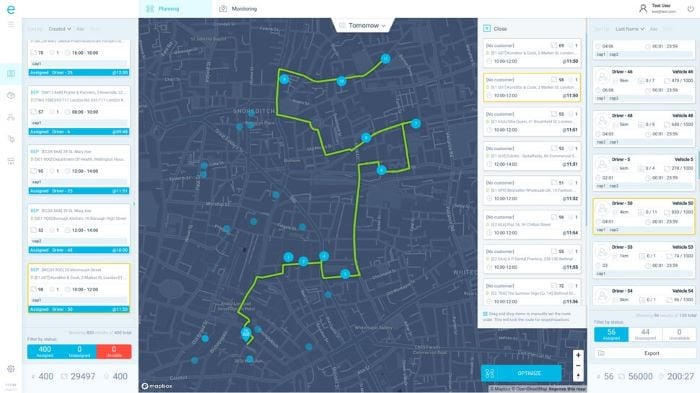
You can also use a route planner to create tasks (order deliveries). But keep in mind that there is a difference between route planning and route optimization.
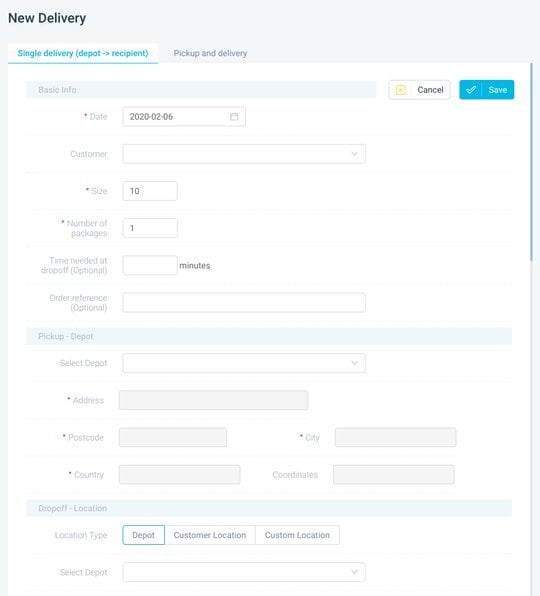
You can do this either manually by uploading tasks one by one, in bulk via CSV files, or using an API to automatically connect it to an order management system.
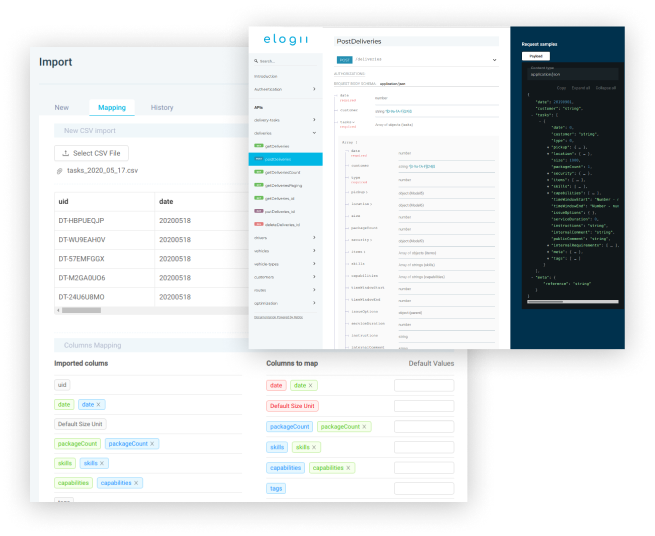
Modern routing tools let you create driver profiles. You can use these driver management capabilities to create routes that match task requirements based on the driver’s vehicle, skill, vicinity, or relationship with the customer.
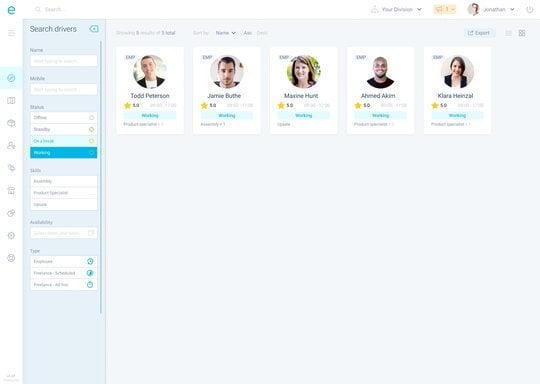
When you’re done planning the routes (and schedules), drivers automatically receive them via the Driver App.
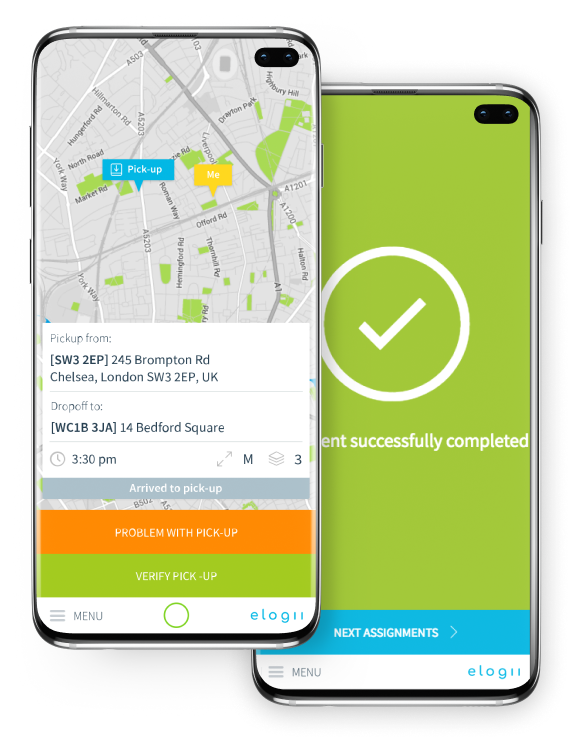
But that doesn’t mean you can’t change them in real-time. A drag-and-drop option lets you arrange and rearrange tasks while the system automatically adjusts the routes for maximum efficiency.
It lets you access detailed information about each route at any given time. That includes ETAs, service, and waiting time for each task, total route distance, time, and vehicle capacity usage.
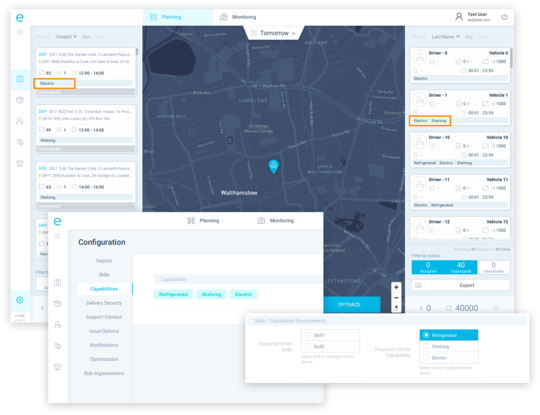
When it comes to your supply chain, you can use the software for single or multi-depot planning. So you can add as many sites as you want.
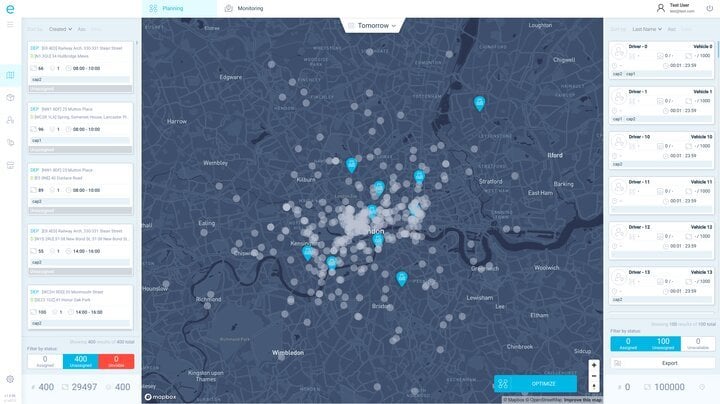
And you can do this for your entire fleet regardless of its size. The tool easily supports five or a hundred vehicles, as well as multiple fleets regardless of whether you have an internal vs. external delivery fleet.
Once everything is in place the entire route planning process takes minutes to complete (depending on how many vehicles and tasks you have).
The system lets you store information about previous tasks, schedules, and routes. So, you can easily retrieve recurring routes.
Technically, you can also use it to track and monitor live operations in real-time.
But it also allows you to set fixed routes based on predetermined collections or delivery orders.
Over time, this feature-rich environment has outgrown its initial purpose. In most cases, today route optimization is just one suite in an end-to-end solution known as the delivery route optimization software.
Despite all of these capabilities, many organizations continue to rely on pen and paper to plan their delivery or service routes.
What’s wrong with manual route planning?
Are you still manually planning routes?
If you are, there are a lot of areas you are losing valuable resources.
First, you are probably highly dependent on one person who has a working knowledge of geography where your distribution takes place.
If that person leaves, the entire operation can quickly fall apart. It’s even worse if it’s a team of people.
It’s also wasteful. There is a lot of untapped potential among your staff that can better serve another area of your organization, like building an agile delivery operation.
So instead of building a flexible operation, you end up relying on fixed routes.
That makes it difficult to assign the best drivers or vehicles to specific tasks (vehicle management), and you miss out on opportunities to optimize and scale.
That leaves you with no room for real-time planning, so you can’t speed up the process.
Seeing how same-day and next-day delivery matters so much to your customers, you lose a competitive advantage without faster operations.
Even if you have been planning routes manually for a long time (and it works), it’s what’s holding back your business.
But route planning software can help you. Here’s how:
Regardless of what route optimization software you choose, there are at least ten ways they can benefit your operations:
#1 It helps you identify the most cost-effective routes.
This is the main feature of route planning software. It relies on advanced algorithms to analyze and determine the best routes based on your parameters.
#2 It reduces the total distance for each route.
Routing software determines driving distance based on the availability of your drivers and vehicles, not to mention tasks and schedule constraints.
It analyzes available resources to create routes that reduce drive time, improve key metrics in delivery logistics, and save money by reducing:
- Fuel costs
- Time spent on the road
- Vehicle wear-and-tear
- Vehicle maintenance costs
- Traffic exposure
- Safety risks
- Insurance and liability costs
#3 It improves responsiveness.
Quick dispatching (for same-day or next-day delivery), impromptu orders, or longer service times require fast rescheduling.
Route optimization tools let dispatchers create orders live, and easily assign them in real-time.
#4 It raises customer satisfaction.
Convenience, speed, and reliability are key factors customers use to determine the quality of your delivery. But they also want a human touch.
Creating driver profiles using delivery route management software lets you match the right driver with the right customer.
The Driver app ensures the best on-time arrival rates by allowing drivers to communicate with customers directly.
Not to mention, it helps nurture customer relationships and loyalty which reduces service windows without affecting the quality of customer service.
#5 It increases the number of tasks you can complete each day.
Because the route delivery software lets you dispatch orders in real-time, drivers can complete more tasks during their runs.
It also maintains workforce happiness, since any additional drop-offs or last-minute changes have the least travel distance.
#6 It maximizes the use of your fleet capacity.
A route optimization tool gives you greater insight into the capacity of each vehicle in your fleet.
This helps you maximize output per vehicle by reducing idle cargo space, as well as maintain operational effectiveness when demand for delivery exceeds your capacities.
#7 It minimizes delays en route.
Reducing the number of minutes your drivers spend in traffic has a significant impact on the cost of your operations.
In fact, a recent survey found that productivity loss due to traffic congestion in 2018 was $87 billion.
Route optimization tools let planners adjust routes based on incoming information from the field, which cuts costs and saves time spent on the road.
#8 It boosts the happiness of your workforce.
Planning routes automatically removes a lot of the pressure from your teams.
On the one hand, this benefits the dispatcher.
As they spend less time planning routes, they can dedicate themselves to driving better results elsewhere.
On the other, drivers feel less frustrated.
Planners can easily create multi-drop routes for drivers based on their preferences, or round trips with tight drop-offs and suitable break times.
And since the driver route software automatically tracks progress and updates it across the delivery management platform, there is less unnecessary communication between teams.
#9 It lets you optimize your fleet.
Optimizing routes helps you discover waste in your operations.
It lets you reassess the size of your fleet with greater precision, so you can right-size the number of vehicles.
And fewer vans or trucks mean fewer field operators, less fuel, less equipment, and less maintenance.
Tracking and tracing the progress of the workforce lets you assess their output.
Driver route planning software can help you identify inefficiencies in the process, as well as your workforce, and optimize before it hinders your operations.
How much does route optimization cost?
The average starting cost of delivery route optimization software is around $20 per vehicle. But this price depends on a few factors.
First, it depends on whether you just want route optimization, or do you want to invest in a more robust system and choose delivery management software.
Then it depends on whether you want to choose an on-premise solution or adopt a cloud-first approach to managing delivery logistics.
On-premise solutions typically cost more and require an upfront payment.
You pay for a perpetual license or sanctioned copy of the fleet routing software, but not the necessary infrastructure that supports it.
Companies like Paragon, Descartes, and Trimble TMW offer these solutions.
SaaS solutions are less expensive.
Instead of buying to own the route management software, you (usually) pay an annual monthly fee to use it.
But the provider supplies the supporting infrastructure, so there are no additional costs.
It’s an operating expense rather than a capital expense (Opex vs. Capex).
The cost also depends on the size of your fleet.
Some SaaS companies set the price per vehicle per month.
Companies like Maxoptra, Routific, and Optimoroute use this method.
And it depends on the features you want and the complexity of your operations.
Companies like eLogii, Onfleet, and Tookan use this payment model.
Today, most companies choose SaaS over on-premise legacy solutions. And tend to pay for features rather than the number of vehicles they operate.
This post explains everything about delivery management software cost.
Is route optimization better than delivery management software?
Yes, but only if you need additional features and capabilities to manage your operations.
Using just route optimization software works best for small businesses.
Those companies that neither have a big fleet nor require additional capabilities, such as reverse logistics.
However, this doesn’t mean you won’t scale your operations at some point.
And delivery route planning software has the upper hand here.
Whether you want to achieve an uninterrupted pharmacy delivery, a way to manage field service operations, or a better way to optimize food delivery in your restaurant, it has you covered.
Here’s what other companies can use the platform:
- Third-party logistics (3PL)
- Grocery and food distributors
- Beverage distributors
- eCommerce and retailers
- Healthcare
- Construction
- Dark kitchens and food delivery
- And more
Strictly speaking, it’s an end-to-end solution that is well-suited to any task or industry or size of the organization.
Plus, that makes it more cost-effective once you grow.
SaaS companies with flexible options that let you pick and choose the capabilities you want to use with pay-as-you-go payment plans.
What’s more, for a slightly higher price you get a feature-rich environment that can serve you for many years.
And because of that, we offer a trial version of our delivery management software.
We have everything you need to start improving your delivery.